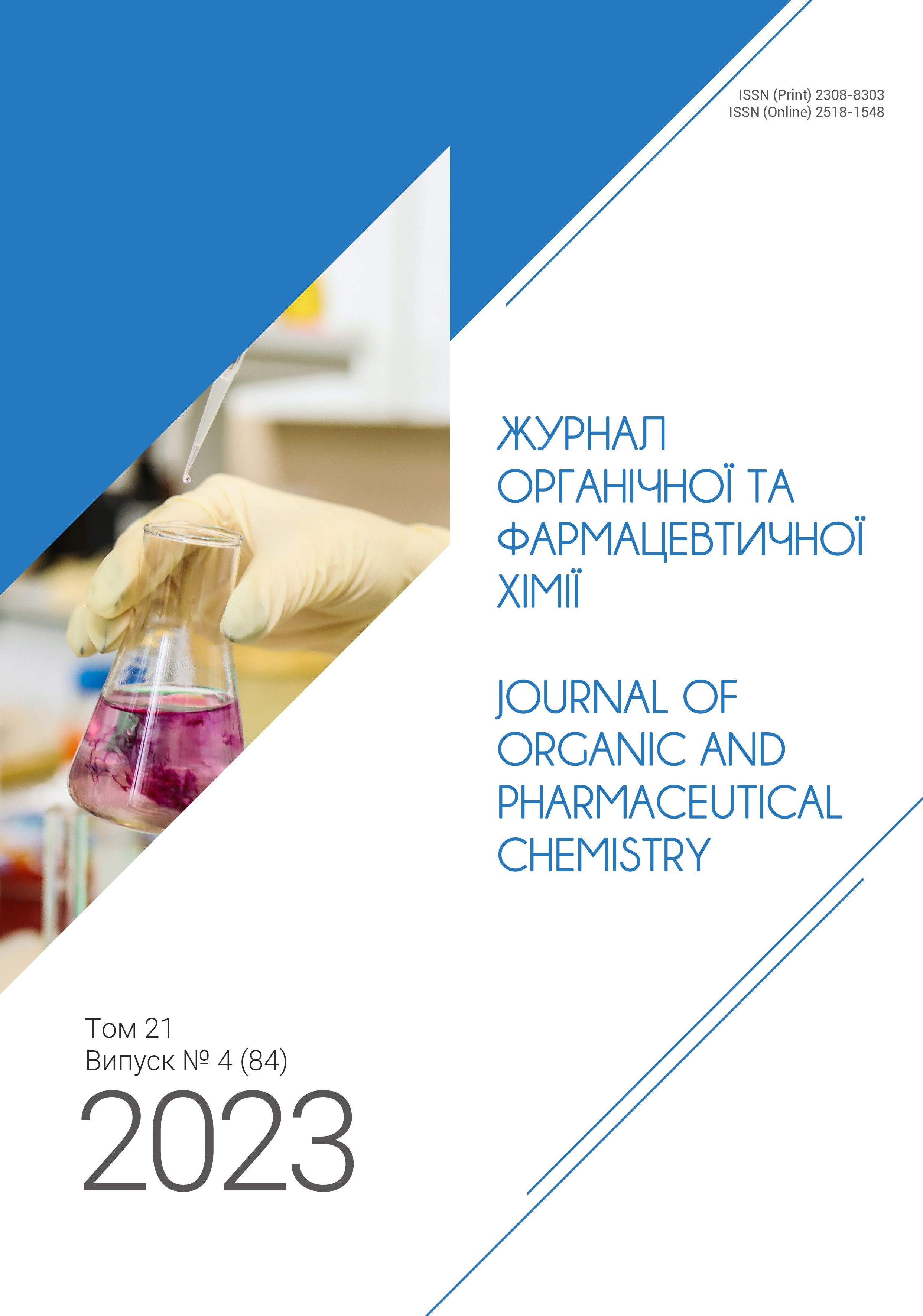Vol. 21 No. 4 (2023)
Full Issue
Advanced Researches
-
Nature-Inspired Tetrahydropentalene Building Blocks: Scalable Synthesis for Medicinal Chemistry Needs
Inspired by the bioactivity of natural compounds with a bicyclo[3.3.0]octane core, the study focuses on developing tetrahydropentalene-2,5-dione (2,5-THP-dione) derivatives as potential building blocks for the use in medicinal chemistry. Using the commercially available 2,5-THP-dione, a number of alkylated derivatives and a monofunctional ketone were synthesized. Using optimized protocols for synthesis, target compounds were obtained with high yields on a multigram scale. These compounds are promising derivatives for further chemical derivatization and therapeutic use, and thus highlight the value of 2,5-THP-dione in creating complex molecular structures for drug discovery, as well as the importance of tetrahydropentalene derivatives as valuable building blocks in synthetic chemistry.
Original Researches
-
Synthesis of a New Series of Chromones Based on Formylthiazoles
A preparative approach to thiazole-containing chromone derivatives has been developed by modifying the corresponding aldehydes with their further transformation into propenone derivatives, and finally introducing them into the Algar-Flynn-Oyamada reaction. Several methods for obtaining propenones have been analyzed, and the most effective and practically convenient one has been found. The thiazole-containing analogs of chromones obtained have a great potential as probes for a wide range of studies.
-
A Simple Preparative Synthesis of Isomeric 2-Chloroquinolinecarboxylic Esters
A simple two-stage method for the synthesis of isomeric esters of 2-chloroquinoline-5-, 6-, 7-carboxylic acids by successive oxidation and chlorination reactions of methyl quinoline-5-, 6-, 7-carboxylates has been developed. The target compounds have been obtained in acceptable yields using readily available reagents, simple transformations, and purification methods. Quinoline-8-carboxylic acid ester is unreactive under these conditions. The ester of 2-chloroquinoline-8-carboxylic acid has been obtained with an overall yield of 55%, starting from 8-methylquinoline. The multi-stage process is paid off by the fact that several transformations occur in one reaction cycle. All the methods developed can be used for the synthesis of target compounds on a multigram scale. Intermediate 2(1H)-oxoquinoline carboxylates are promising compounds in the synthesis of functionalized and condensed heterocycles.
-
An Efficient Synthesis of PARP Inhibitors Containing a 4-Trifluoromethyl Substituted 3,6,7,7a-Tetrahydro- 1H-pyrrolo[3,4-d]pyrimidine-2,5-dione Scaffold
Poly(ADP-ribose) polymerases (PARPs) are key enzymes in the DNA repair pathway. Inhibitors of these enzymes belong to a new type of anticancer drugs that selectively kill cancer cells by targeting the homologous recombination genetic defects. This study presents a new synthetic approach to PARP inhibitors containing a 4-trifluoromethyl substituted 3,6,7,7a-tetrahydro-1H-pyrrolo[3,4-d]pyrimidine-2,5-dione scaffold. The method is based on a practical one-step cyclocondensation of 2-(2-oxo-1,2,3,4-tetrahydropyrimidin-4-yl)acetic acid derivatives via the Curtius rearrangement of the corresponding acyl azides formed in situ upon the treatment with diphenylphosphoryl azide. The resulting products have been found to possess a potent inhibitory effect on PARP-1 and PARP-2 isoforms of poly(ADP-ribose) polymerases. The structure–activity analysis has revealed that the N1-aryl substituent is crucial to the selectivity and high potency towards PARP-2, and that the p-fluorobenzyl group is the optimal group for the non-selective and potent PARP-1 and PARP-2 inhibition.
-
Inhibition of Xanthine Oxidase by Pyrazolone Derivatives Bearing a 4-(Furan-2-yl)benzoic Acid Moiety
The pyrazolone-based 4-(furan-2-yl)benzoic acids have been synthesized and studied as xanthine oxidase inhibitors. This enzyme is one of the therapeutic targets for the treatment of hyperuricemia and related diseases. The compounds studied have found to exhibit low micromolar IC50 values relative to the enzyme in vitro, depending on substituents in position 3 of the pyrazolone ring. However, the inhibitory effects observed are reduced in the presence of bovine serum albumin or Tween-80. Among the pyrazolone derivatives synthesized, 4-(5-((3-methyl-5-oxo-1-phenyl-1,5-dihydro-4H-pyrazol-4-ylidene)methyl)furan-2-yl)benzoic acid has been found to be the most potent inhibitor of xanthine oxidase. Kinetic results have shown that this compound is a mixed-type inhibitor with higher affinity to the free enzyme than to the enzyme-substrate complex. The results of the molecular docking and molecular dynamics show that the carboxylic group of the inhibitor can form a salt bridge with Arg880 and a hydrogen bond with Thr1010. These interactions can be key factors in the enzyme-inhibitor complex stabilization.
-
The Synthesis of Functionalized Dimethylphosphinoyl Cyclopropanes and Cyclobutanes
A simple preparative approach to a series of functionalized dimethylphosphinoyl-containing cyclopropanes and cyclobutanes has been developed; it is based on cyclocondensation of dimethylphosphinoyl acetonitrile with 1,2- and 1,3-dibromoalkanes. Synthetic procedures for obtaining nitriles, amines and carboxylic acids containing in their structure small saturated cyclic rings of cyclopropane or cyclobutane and a dimethylphosphine oxide fragment, which are popular in drug design, have been developed.
-
The Study of Compounds Distilled with Water Vapor in Cetraria islandica (L.) Ach. Thalli Harvested in Ukraine
The component composition and the quantitative content of compounds distilled with water vapor in the thalli of Cetraria islandica (L.) Ach. harvested in Ukraine were determined using the method of gas chromatography with mass spectrometric detection (GC/MS). 24 compounds distilled with water vapor were identified with the prevalence of fatty acids and their derivatives (57.86±2.00% of the total compounds), terpenoids and their derivatives (23.57±0.97% of the total compounds) and acyclic saturated hydrocarbons (10.99±0.45% of the total compounds). The highest percentage was observed for octadecadienoic (linoleic) acid (20.08±0.67% of the total compounds), hexadecanoic (palmitic) acid (19.21±0.77% of the total compounds) and 9,17-octadecadienal (18.57±0.56% of the total compounds). The presence of 4 monoterpenoids and 6 sesquiterpenoids in the raw material studied was determined for the first time.










